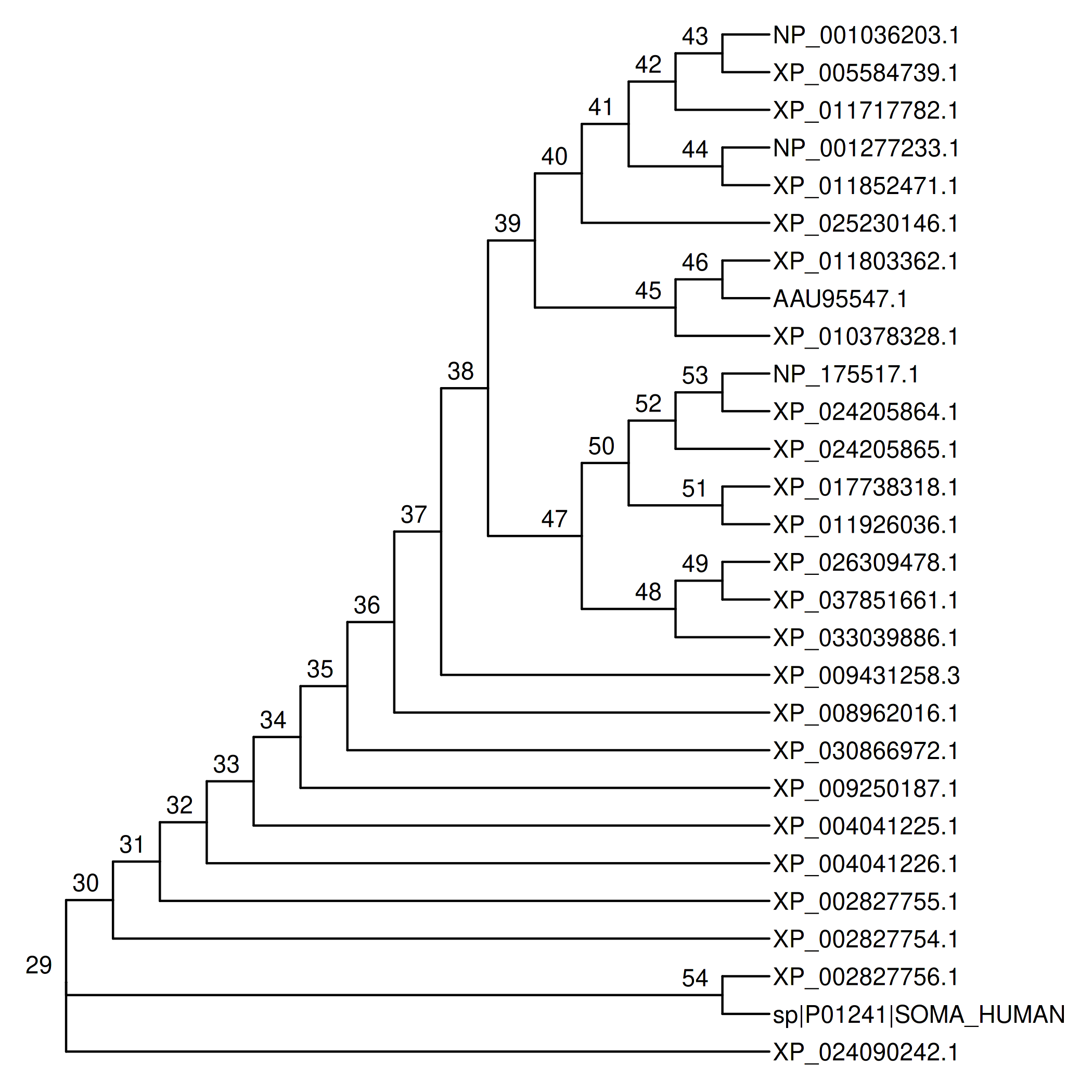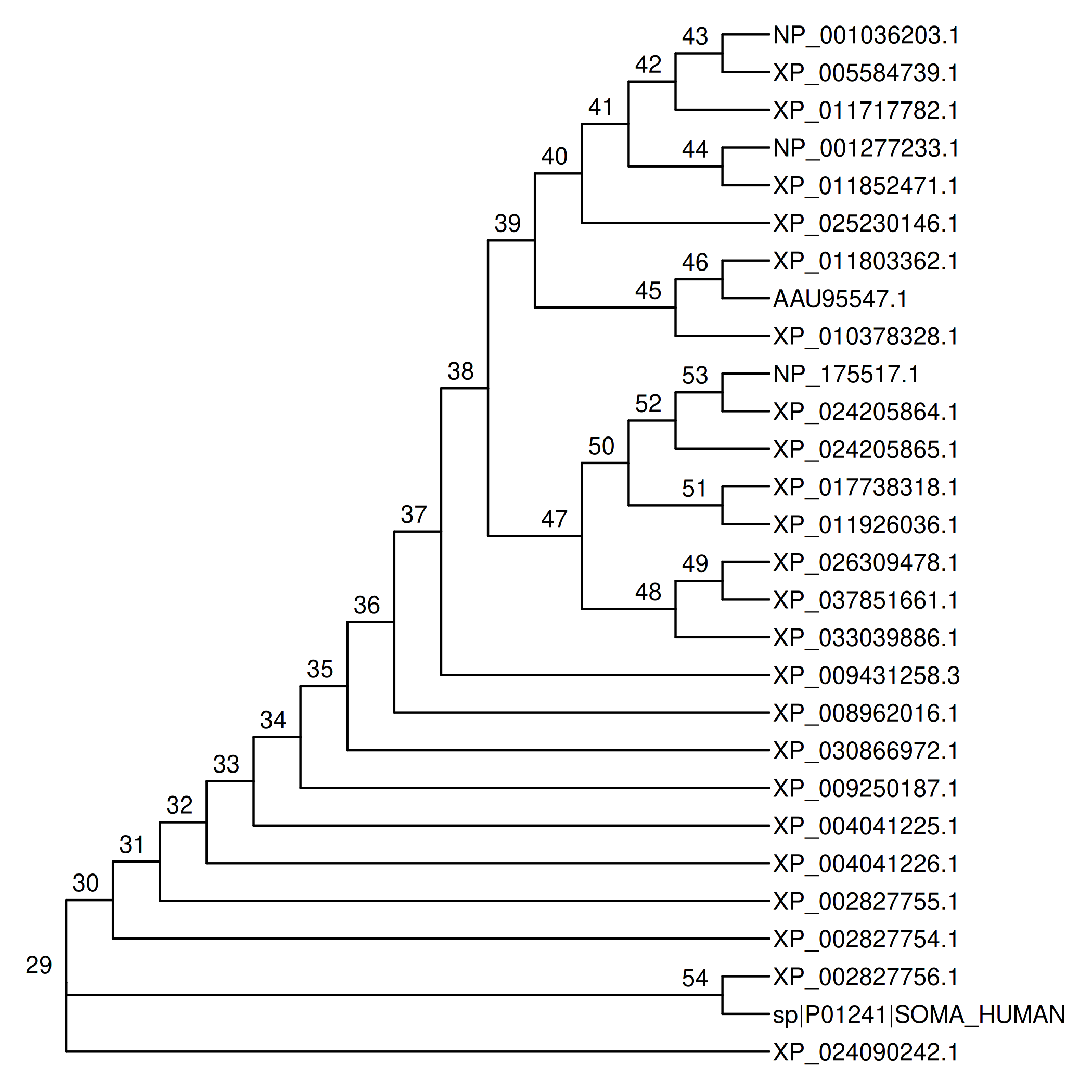 |
|---|
| © Karobben |
由於語法渲染問題而影響閱讀體驗, 請移步博客閱讀~
本文GitPage地址
Align your Sequence
Set your arguments
INPUT = ""OUTPUT = ""ARG_TREE = "" # NJ / UPGMA
Import libraries
import os
from Bio.Align.Applications import ClustalwCommandline
from Bio import AlignIO
from Bio import Phylo
Pre-align
cwline = ClustalwCommandline("clustalw2", infile= INPUT, outfile = OUTPUT + ".fasta", output= "fasta" )
print(cwline)
stdout, stderr = cwline()
clustalw2 -infile=Base.fa -outfile=assignment2.fasta -output=fasta
Trimming the gap
Gap from the head and tail could have huge effects on the result of the tree. So, we should avoid the side effects from the gaps because of the length-difference.
Here, we just counting the gaps from the head and tail of each sequences and retain the largest number. On the other hand, the numbers’ of gap extension were printed out so you can customize your own.
## reading the alignments
align = AlignIO.read(OUTPUT + ".fasta", "fasta")
## Count the longest space on the head
Gap_head = 0
Gap_tail = 0
Gap_list_head = []
Gap_list_tail = []
for seq_tmp in align:
Num = 0
while seq_tmp[Num] == "-":
Num +=1
Gap_list_head += [Num]
if Num > Gap_head:
Gap_head = Num
## Count the longest space on the tail
for seq_tmp in align:
Num = 0
while seq_tmp[::-1][Num] == "-":
Num +=1
Gap_list_tail += [Num]
if Num > Gap_tail:
Gap_tail = Num
print("\nGap head list: ", Gap_list_head,
"\nGap head tail: ", Gap_list_tail)
print("\nGap head: ", Gap_head,
"\nGap head: ", Gap_tail)
## Count the longest space on the head
# Alignment objects can be manipulated
# slice alignment
align_slice = align[:, Gap_head : len(seq_tmp)-Gap_tail]
print ("Slice of alignment from position " + str(Gap_head) + " to " + str(Gap_tail) +"\n")
print(align_slice)
## wirte it out
F = open(OUTPUT + "_scliced.fa", 'w')
F2 = open(OUTPUT + "_gap.fa", 'w')
for Seq_tmp in align_slice:
F.write(">" + Seq_tmp.id+"\n")
F2.write(">" + Seq_tmp.id+"\n")
Seq_seq = str(Seq_tmp.seq)
F2.write(Seq_seq+"\n")
Seq_seq = Seq_seq.replace("-","")
F.write(Seq_seq+"\n")
F.close()
F2.close()
Gap head list: [115, 115, 86, 86, 86, 115, 115, 115, 115, 115, 115, 115, 115, 115, 115, 115, 115, 115, 115, 91, 170, 70, 115, 117, 0, 115, 115, 192]
Gap head tail: [13, 13, 13, 13, 13, 13, 13, 13, 13, 13, 13, 13, 13, 13, 13, 13, 13, 13, 13, 13, 13, 13, 13, 13, 13, 0, 0, 12]
Gap head: 192
Gap head: 13
Slice of alignment from position 192 to 13
Alignment with 28 rows and 167 columns
Build the tree
##
# Make Phylogenetic Tree
cwline = ClustalwCommandline("clustalw2", infile= OUTPUT + "_gap.fa", clustering = ARG_TREE, bootstrap = 1000)
print(cwline)
stdout, stderr = cwline()
tree = Phylo.read(OUTPUT.split(".")[0]+"_gap.phb", "newick")
Phylo.draw_ascii(tree)
# select the 3 sequences in the top branch of phylo tree
align_branch = align_slice[0:3]
print(align_branch)
, XP_009431258.3
|
| , XP_005584739.1
| |
|,| NP_001036203.1
|||
||| XP_011717782.1
||
|, XP_011852471.1
||
|| NP_001277233.1
||
,| XP_025230146.1
||
|, AAU95547.1
||
|| XP_011803362.1
||
|| XP_010378328.1
|
| , XP_033039886.1
|,|
|||__ XP_037851661.1
|||
|||________ XP_026309478.1
||
|| ___ XP_011926036.1
||,|
||||_____ XP_017738318.1
|||
| | _______________ XP_024205865.1
| |_________|
| |_______________ XP_024205864.1
| |
| |_________________________________________ NP_175517.1
|
| XP_008962016.1
|
| XP_030866972.1
|
| XP_009250187.1
|
| XP_004041225.1
|
| XP_004041226.1
|
| XP_002827755.1
|
| XP_002827754.1
_|
, sp|P01241|SOMA_HUMAN
|
| XP_002827756.1
|
| XP_024090242.1
Visualizing it with ggtree
Reference: ggplot2 extensions; 2016
args <- commandArgs(trailingOnly = TRUE)
print("Input", str(args))
library("ggtree")
tree <- read.tree(args)
ggtree(tree, branch.length = 'none') +
geom_text2(aes(subset=!isTip, label=node), hjust= 1.5, vjust = -0.5) +
geom_tiplab() +
xlim(NA, 15 + length(strsplit(tree$tip.label[1], "*")[[1]])/2.5)
ggsave(paste(args, ".png", sep=""))
### save the tree as png
PATH_lib = os.path.dirname(__file__)
CMD = "Rscript " + PATH_lib + "/lib/R/ggtree.R " + OUTPUT + "_gap.phb"
print(CMD)
os.system(CMD)

How to use
The quickest way:
- input file:
sample.fasta - output file prefix:
result - tree type:
UPGMA
Seq2tree.py -i sample.fasta -o result -t UPGMA
results:
result.fasta: original aligned file (with gaps)
result_gap.fa: Trimmed file (with gaps)
result_scliced.Trimmed file (without gaps)
result_gap.phb: Tree file
result_gap.phb.png: Tree visualizing with ggtree—-
Enjoy~
本文由Python腳本GitHub/語雀自動更新
由於語法渲染問題而影響閱讀體驗, 請移步博客閱讀~
本文GitPage地址
GitHub: Karobben
Blog:Karobben
BiliBili:史上最不正經的生物狗

